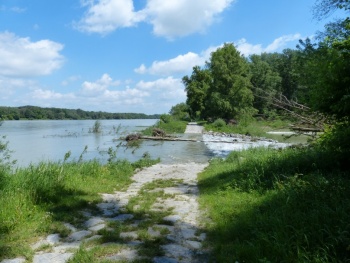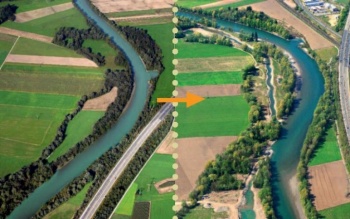Difference between revisions of "Improve backwaters"
(New page: =Improve backwaters= Improve backwatersFloodplains/off-channel/lateral connectivity habitats improvement ==General description == Improve backwaters (e.g. morphology, vegetation) ==Appli...) |
|||
| (3 intermediate revisions by 3 users not shown) | |||
| Line 1: | Line 1: | ||
| + | [[File:Improve backwaters foto 1.jpg|350px|thumbnail|Reconnection of a backwater channel at the Danube in Austria (source : BOKU, IHG)]] | ||
| + | ==General description== | ||
| + | Backwaters can be described as rather small water bodies with little or no current of their own that may be seasonally or permanently inundated and are connected to the main river channel (Kampa and Stein, 2012). | ||
| + | This restoration type comprises habitat enhancement measures such as the reconnecting or the creating of lentic backwaters or small backwaters with low flow velocity (Schmutz et al. 2014). | ||
| + | [[File:Improve back waters foto 2.jpg|350px|thumbnail|Amlach/St. Peter before (2009) and after completion in 2011. Taken from Life vein – Upper Drau River (2011)]] | ||
| − | + | The creation of new floodplain waters with a permanent connection and a constant, moderate flow probalby has the highest potential for supporting reophilic fish community (Grift et al. 2001). Side arm structures in the more lenitic central impoundment are mainly important for eurytopic species, but also host young age classes of rheophilic species, and provide sufficient prey fish for predators (Chovanec et al. 2002). | |
| − | + | ||
| − | == | + | ==Applicability== |
| − | + | It is important to ensure that these habitats are connected to the river at least seasonally, but preferably consistently throughout the year (Roni et al. 2005), since backwaters can quickly fill up with sediments. | |
| − | + | ||
| − | ==Expected effect of measure on (including literature citations): == | + | ==Expected effect of measure on (including literature citations)== |
| − | + | {| {{table}} | |
| − | + | | align="center" style="background:#f0f0f0;"|'''Category''' | |
| − | + | | align="center" style="background:#f0f0f0;"|'''Description''' | |
| − | ==Temporal and spatial response | + | | align="center" style="background:#f0f0f0;"|'''Source (citation)''' |
| + | |- | ||
| + | | HYMO|||| | ||
| + | |- | ||
| + | | |||| | ||
| + | |- | ||
| + | | Macrophytes||Diversity of submerged and emergent aquatic macrophytes increased||Willby and Eaton 1996 | ||
| + | |- | ||
| + | | Macroinvertebrats|||| | ||
| + | |- | ||
| + | | Fish||Provide critical spawning and nursery habitat for a variety of fishes, Increased number of species||Buijse et al. 2002, Schmutz et al. 2014 | ||
| + | |} | ||
| + | ==Temporal and spatial response== | ||
| + | Not available. | ||
==Pressures that can be addressed by this measure == | ==Pressures that can be addressed by this measure == | ||
<Forecasterlink type="getPressuresForMeasures" code="M60" /> | <Forecasterlink type="getPressuresForMeasures" code="M60" /> | ||
| − | ==Cost-efficiency == | + | ==Cost-efficiency== |
| + | Not available. | ||
==Case studies where this measure has been applied == | ==Case studies where this measure has been applied == | ||
<Forecasterlink type="getProjectsForMeasures" code="M60" /> | <Forecasterlink type="getProjectsForMeasures" code="M60" /> | ||
==Useful references == | ==Useful references == | ||
| + | *Buijse, A. D., H. Coops, M. Staras, L. H. Jans, G. J. Vangeest, R. E. Grift, B. W. Ibelings, W. Oosterberg, and F. C. J. M. Roozen (2002). Restoration strategies for river floodplains along large lowland rivers in Europe. Freshwater Biology 47, 899-907. | ||
| + | *Chovanec, A., F. Schiemer, H. Waidbacher, and R. Spolwind (2002). Rehabilitation of a heavily modified river section of the Danube in Vienna (Austria): biological assessment of landscape linkages on different scales. International Review of Hydrobiology, 87, 2–3. | ||
| + | *Grift, R.E., A. D. Buijse, W. L. T. van Densen, J. G. P. Klein (2001). Restoration of river-floodplain interaction: benefits for the fish community in the river Rhine. Archiv für Hydrobiologie, 135, 2-4. Large Rivers, 12 , 173-182. | ||
| + | *Kampa, E. and U. Stein (2012). Factsheets on Environmental Effectiveness of Selected Hydro-morphological Measures. Contract No. 070311/2011/603663/ETU/DI ‘Comparative Study of Pressures & Measures in the Major River Basin Management Plans’ (Task 3b). Ecologic Institute, Berlin. DG ENV study carried out by a consortium led by WRc. | ||
| + | *Roni, P., K. Hanson, T. Beechie, G. Pess, M. Pollock, and D. M. Bartley (2005). Habitat rehabilitation for inland fisheries. Global review of effectiveness and guidance for rehabilitation of freshwater ecosystems. FAO Fisheries Technical Paper, 484. | ||
| + | *Schmutz, S., H. Kremser, A. Melcher, M. Jungwirth, S. Muhar, H. Waidbacher, and G. Zauner (2014). Ecological effects of rehabilitiation measures at the Austrian Danube: a meta analysis of fish assemblages. Hydrobiologia, 729, 49-60. | ||
| + | Restoration strategies for river floodplains along large lowland rivers in Europe | ||
| + | *Willby, N. J., and J. W. Eaton (1996). Backwater habitats and their role in nature conservation on navigable waterways. Hydrobiologia, 340, 333-338. | ||
| + | |||
==Other relevant information == | ==Other relevant information == | ||
| − | [[Category:Measures]][[Category:Floodplains/off-channel/lateral connectivity habitats improvement]] | + | [[Category:Measures]][[Category:08. Floodplains/off-channel/lateral connectivity habitats improvement]] |
Latest revision as of 21:20, 8 December 2015
Contents
- 1 General description
- 2 Applicability
- 3 Expected effect of measure on (including literature citations)
- 4 Temporal and spatial response
- 5 Pressures that can be addressed by this measure
- 6 Cost-efficiency
- 7 Case studies where this measure has been applied
- 8 Useful references
- 9 Other relevant information
General description
Backwaters can be described as rather small water bodies with little or no current of their own that may be seasonally or permanently inundated and are connected to the main river channel (Kampa and Stein, 2012). This restoration type comprises habitat enhancement measures such as the reconnecting or the creating of lentic backwaters or small backwaters with low flow velocity (Schmutz et al. 2014).
The creation of new floodplain waters with a permanent connection and a constant, moderate flow probalby has the highest potential for supporting reophilic fish community (Grift et al. 2001). Side arm structures in the more lenitic central impoundment are mainly important for eurytopic species, but also host young age classes of rheophilic species, and provide sufficient prey fish for predators (Chovanec et al. 2002).
Applicability
It is important to ensure that these habitats are connected to the river at least seasonally, but preferably consistently throughout the year (Roni et al. 2005), since backwaters can quickly fill up with sediments.
Expected effect of measure on (including literature citations)
| Category | Description | Source (citation) |
| HYMO | ||
| Macrophytes | Diversity of submerged and emergent aquatic macrophytes increased | Willby and Eaton 1996 |
| Macroinvertebrats | ||
| Fish | Provide critical spawning and nursery habitat for a variety of fishes, Increased number of species | Buijse et al. 2002, Schmutz et al. 2014 |
Temporal and spatial response
Not available.
Pressures that can be addressed by this measure
Cost-efficiency
Not available.
Case studies where this measure has been applied
- Charlottenburg artificial bay
- Renaturierung Untere Havel
- Vén Duna - side arm reopening
- Millingerwaard - Floodplain rehabilitation
- River Roding at Ray Lodge Park
- River Wensum Rehabilitation Project - Billingford
- River Skerne EU-LIFE project
- Buiten Ooij - Sluice operation
- Niederwerrieser Weg - Optimisation of the pSCI “Lippe floodplain between Hamm and Hangfort” (LIFE05/NAT/D/000057)
- Oberwerries - Optimisation of the pSCI “Lippe floodplain between Hamm and Hangfort” (LIFE05/NAT/D/000057)
- Ahlen-Dolberg - Optimisation of the pSCI “Lippe floodplain between Hamm and Hangfort” (LIFE05/NAT/D/000057)
- Soest - Optimisation of the pSCI “Lippe floodplain between Hamm and Hangfort” (LIFE05/NAT/D/000057)
- IJssel
- River Cole EU-LIFE
- Rhine - Ontpoldering Noordwaard
- Donau - Aggsbach (LIFE03 NAT/A/000009)
- Lower Traun
- Lippeaue Klostermersch
- Ruhr Binnerfeld
Useful references
- Buijse, A. D., H. Coops, M. Staras, L. H. Jans, G. J. Vangeest, R. E. Grift, B. W. Ibelings, W. Oosterberg, and F. C. J. M. Roozen (2002). Restoration strategies for river floodplains along large lowland rivers in Europe. Freshwater Biology 47, 899-907.
- Chovanec, A., F. Schiemer, H. Waidbacher, and R. Spolwind (2002). Rehabilitation of a heavily modified river section of the Danube in Vienna (Austria): biological assessment of landscape linkages on different scales. International Review of Hydrobiology, 87, 2–3.
- Grift, R.E., A. D. Buijse, W. L. T. van Densen, J. G. P. Klein (2001). Restoration of river-floodplain interaction: benefits for the fish community in the river Rhine. Archiv für Hydrobiologie, 135, 2-4. Large Rivers, 12 , 173-182.
- Kampa, E. and U. Stein (2012). Factsheets on Environmental Effectiveness of Selected Hydro-morphological Measures. Contract No. 070311/2011/603663/ETU/DI ‘Comparative Study of Pressures & Measures in the Major River Basin Management Plans’ (Task 3b). Ecologic Institute, Berlin. DG ENV study carried out by a consortium led by WRc.
- Roni, P., K. Hanson, T. Beechie, G. Pess, M. Pollock, and D. M. Bartley (2005). Habitat rehabilitation for inland fisheries. Global review of effectiveness and guidance for rehabilitation of freshwater ecosystems. FAO Fisheries Technical Paper, 484.
- Schmutz, S., H. Kremser, A. Melcher, M. Jungwirth, S. Muhar, H. Waidbacher, and G. Zauner (2014). Ecological effects of rehabilitiation measures at the Austrian Danube: a meta analysis of fish assemblages. Hydrobiologia, 729, 49-60.
Restoration strategies for river floodplains along large lowland rivers in Europe
- Willby, N. J., and J. W. Eaton (1996). Backwater habitats and their role in nature conservation on navigable waterways. Hydrobiologia, 340, 333-338.

